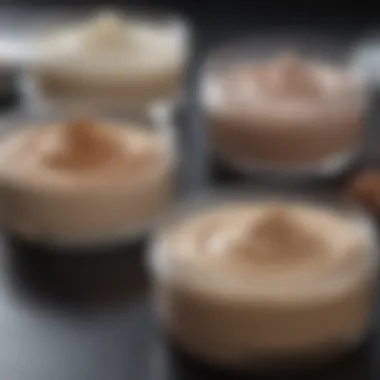Top Fade Creams for African American Skin


Intro
Skin discoloration impacts many individuals, particularly within the African American community. It is essential to address this issue with care and tailored solutions. Over-the-counter fade creams offer a convenient approach to ameliorate hyperpigmentation and other skin imperfections. This article provides a thorough examination of the foremost fade creams formulated for African American skin, analyzing the key ingredients, application methods, and user experiences.
The focus is on identifying effective products and discussing their relevance in promoting an even skin tone. This guide aims to equip readers with knowledge to make informed decisions about fade creams, catering to women of all ages who seek to enhance their skin health.
Understanding Skin Discoloration
Skin discoloration can stem from various factors including sun exposure, hormonal changes, and inflammation. African American skin often presents unique challenges due to differences in melanin production and skin thickness, leading to distinct patterns of hyperpigmentation. Knowing these dynamics is crucial for selecting the right fade cream.
Some common conditions that cause discoloration include:
- Post-inflammatory hyperpigmentation
- Melasma
- Age spots
The Importance of Choosing the Right Fade Cream
Selecting a fade cream specifically intended for African American skin enhances effectiveness. Such products often contain ingredients that not only address discoloration but also nurture skin texture and hydration. Given the delicate balance of addressing pigmentation without causing irritation, understanding product formulations is vital.
"Understanding the specific needs of African American skin can lead to more effective treatment options, resulting in healthier and more radiant skin."
Effective fade creams offer both immediate results and long-term benefits, making educated choices essential.
Next, we will explore the top categories of fade creams, emphasizing effectiveness and suitability for various skin types.
Foreword to Skin Discoloration
Skin discoloration is a significant concern for many individuals, and it is especially pertinent for African American skin. It goes beyond mere aesthetics, as skin discoloration can impact self-esteem and overall mental wellbeing. Understanding how and why skin discoloration occurs allows for better skincare choices and effective treatments. In this article, we will focus on fade creams that are available over-the-counter and specifically beneficial for African American skin tone.
There are specific challenges that arise with various types of skin discoloration, such as hyperpigmentation. For those with deeper skin tones, it is essential to identify the right products that cater to individual needs. This guide will provide a comprehensive overview of fade creams available today, their active ingredients, and how they can assist in reducing the appearance of dark spots and uneven skin tone.
Additionally, discussions surrounding safe application techniques and ingredient sensitivities will offer valuable insights. Taking these factors into account can lead to better skincare practices and enhanced efficacy of treatments. Understanding skin discoloration equips one with the knowledge to navigate the plethora of products available in the market.
Understanding Hyperpigmentation
Hyperpigmentation refers to the darkening of an area of skin due to excess melanin production. It manifests as dark spots, patches, or uneven skin tone. African American skin often becomes a canvas for this condition due to its higher melanin content, making it susceptible to blemishes and discoloration after injuries, inflammation, or sun exposure.
Several factors contribute to hyperpigmentation, including:
- Post-inflammatory responses: This might occur due to acne or other skin injuries.
- Hormonal changes: Conditions like melasma can occur, often linked to pregnancy or hormonal treatments.
- Sun exposure: Ultraviolet rays can exacerbate skin darkening and should be protected against.
To effectively address hyperpigmentation, one needs to consider fade creams that include ingredients known for their lightening properties and overall skin benefits.
Common Causes of Skin Discoloration
Understanding the various causes of skin discoloration is crucial for proper treatment and prevention. Common causes include:
- Sun damage: Prolonged exposure to the sun can lead to sunspots and uneven skin tone.
- Hormonal fluctuations: Changes in hormone levels can trigger the melasma condition, especially in women.
- Ageing: With age, the skin may lose elasticity and develop uneven pigmentation.
- Skin conditions: Issues like eczema or psoriasis can lead to post-inflammatory hyperpigmentation.
- Medications: Certain drugs can affect skin pigmentation and contribute to discoloration.
Tackling these causes requires a consistent skincare routine, which might include the use of fade creams with appropriate active ingredients. It is important to select products that do not irritate sensitive skin types commonly found in African Americans.
Specific Concerns for African American Skin
The topic of specific concerns for African American skin is crucial when discussing fade creams. Different skin types have unique needs and challenges. African American skin often faces issues like hyperpigmentation, which can arise from various factors. Understanding these concerns is essential for effective treatment and care.


One key consideration is the natural melanin content in African American skin. This higher melanin level can lead to darker spots and uneven tones when faced with inflammation or injuries. Choosing the appropriate fade cream requires knowledge about the specific features of this skin type and how those features can influence product effectiveness.
Characteristics of African American Skin
African American skin is often thicker and more resilient compared to other skin types. This thickness can dictate how products interact with the skin. However, it is also prone to conditions like keloids, where scars can become raised and darker than the surrounding skin. Therefore, any treatment for skin discoloration must be chosen with care to avoid exacerbating these conditions.
The skin's texture is frequently oilier, which may sometimes result in larger pores. Consequently, selecting a fade cream that does not clog these pores is vital. Many fade creams contain exfoliating agents, which can effectively clear out impurities, but they should be less aggressive to avoid irritation.
Sensitivity to Certain Ingredients
The sensitivity of African American skin to certain ingredients is another important aspect to consider. Some individuals may have adverse reactions to common components found in popular fade creams, such as hydroquinone and retinoids. These reactions can include irritation, redness, or even increased pigmentation.
To achieve optimal results, it is advisable to conduct patch tests before fully integrating a product into a skincare routine. People with darker skin tones must be cautious about products that can trigger post-inflammatory hyperpigmentation.
It is important to look for gentle and effective alternatives. Ingredients like glycolic acid, vitamin C, and niacinamide are often well-tolerated and can provide benefits without significant side effects. Research on product formulations helps identify those that suit individual skin sensitivities.
Choosing a fade cream requires understanding the unique needs of African American skin, particularly its sensitivity and characteristics.
Choosing the Right Fade Cream
Selecting the appropriate fade cream is crucial for achieving desired results in treating skin discoloration. Fade creams aim to reduce hyperpigmentation, which often causes concern among many individuals, especially within the African American community. Insufficient awareness around fade creams can lead to unsuitable choices, exacerbating existing skin issues or causing new ones. Therefore, understanding how to choose the right product can provide a significant impact on both efficacy and skin health.
Key Ingredients to Look For
When looking for an effective fade cream, attention should be paid to specific active ingredients known for their ability to reduce hyperpigmentation. Some key components include:
- Hydroquinone: This ingredient lightens skin by decreasing melanin production. It is highly effective but should be used cautiously and under professional guidance.
- Kojic Acid: Derived from fungi, kojic acid can inhibit melanin on a cellular level. It’s often well-tolerated and suitable for longer-term use compared to some other agents.
- Vitamin C: Known for its antioxidant properties, Vitamin C can also brighten skin and improve overall tone without harsh side effects.
- Niacinamide: This compound can reduce the appearance of dark spots and improve skin texture. It also enhances skin barrier function, making it a good choice for sensitive skin.
- Azelaic Acid: Effective in treating both acne and hyperpigmentation, azelaic acid can provide dual benefits, making it a versatile option.
These ingredients are widely recognized for their safety and effectiveness when formulated well within a cream. Always check the concentration and the manufacturer's recommendations to ensure optimal results.
Ingredients to Avoid
While seeking the best fade cream, it is just as important to know what to avoid. Certain ingredients may cause irritation or other complications, especially for African American skin that might be more prone to adverse reactions. Here are some to watch out for:
- Alcohol: High concentrations of alcohol can lead to dryness and irritation, disrupting the skin barrier. It's best to avoid products with alcohol listed as a primary ingredient.
- Fragrance: Artificial fragrances can provoke allergic reactions and sensitivity, making them not ideal for topical applications.
- Parabens: Often used as preservatives, parabens have faced scrutiny due to potential hormone-disrupting effects. It is safer to choose paraben-free formulations.
- Steroids: Prolonged use of topical steroids for skin lightening can lead to thinning skin and other side effects, making them unsuitable for fade cream purposes.
Being informed about harmful ingredients helps in making a conscious decision for skin health and safety.
Chemical versus Natural Ingredients
The debate between chemical and natural fade creams is quite significant. On one hand, chemical ingredients like hydroquinone can deliver faster visible results in reducing pigmentation. However, they may also present side effects, especially with long-term use. On the other hand, natural ingredients often take longer to show substantial results, but they typically have a lower risk of irritation.
- Chemical Fade Creams: These usually contain potent ingredients like hydroquinone or kojic acid. They are designed for stronger treatment but require caution due to potential side effects such as skin redness or peeling.
- Natural Fade Creams: These creams often focus on botanical extracts or vitamins. While they may offer gentler treatment, results can be slower. However, they tend to be safer for sensitive skin types.
Ultimately, the choice depends on individual skin conditions, sensitivities, and personal preference. It is advisable to consult with a dermatologist to evaluate both options and decide the best course of action for one’s skin type.
Proper selection of fade cream based on ingredients helps in addressing skin concerns effectively and safely, providing a clear path to achieving an even skin tone.
Top Recommended Over-the-Counter Fade Creams
The selection of the right fade cream is vital for those dealing with skin discoloration, especially for African American skin. This section highlights the most effective over-the-counter fade creams that can help achieve a more even skin tone. It is important to recognize that not all products are created equal; working with the unique characteristics of African American skin requires understanding what differs in formulation and how those differences impact effectiveness. Therefore, a nuanced approach to product evaluation is necessary, considering both the active ingredients and user feedback.
Product Reviews and Ratings


When assessing fade creams, the quality of user reviews and their ratings can guide purchasing decisions. Here are some standout products worthy of mention:
- Ambi Skincare Fade Cream
This cream is notable for its formulations with hydroquinone as a main ingredient. Users often praise its effectiveness in reducing dark spots when used consistently. Many appreciate its affordability and how easily it spreads on the skin. - Palmer's Skin Success Fade Cream
Palmer's offers a formula enriched with vitamin E, which can help moisturize while fading uneven skin tones. Customers report significant improvement within a couple of months, provided they use sunscreen daily. - CeraVe Skin Renewing Vitamin C Serum
Though technically a serum rather than a cream, its potency in brightening skin through vitamin C makes it a popular choice. Users find it non-irritating and effective for regular use. - Neutrogena Rapid Tone Repair Dark Spot Corrector
This product includes retinol, which can accelerate skin cell turnover, leading to faster fading of dark spots. The lightweight texture is often highlighted as a favorable feature by users.
User ratings on platforms like Amazon and skincare forums provide practical and experienced insights into these fade creams. Checking these ratings can help gauge overall satisfaction and potential effectiveness of each product.
Price Comparisons and Accessibility
Affordability and accessibility are crucial factors in selecting over-the-counter fade creams. Many effective products are available at drugstores and major retailers. Here’s a summary of price points and accessibility options:
- Ambi Skincare Fade Cream: Typically found in drugstores for around $10, this product falls into the budget category while still providing promising results.
- Palmer's Skin Success Fade Cream: Priced similarly to Ambi, it is accessible through various retail channels, including online marketplaces and specialty beauty suppliers.
- CeraVe Skin Renewing Vitamin C Serum: This serum has a higher price point, usually around $20, but its effectiveness may justify the cost for some users. It is widely available online and in physical stores.
- Neutrogena Rapid Tone Repair Dark Spot Corrector: This product's price generally hovers around $25, making it among the higher-priced options. It can be purchased at most drugstores or large retail chains.
Application Techniques
Understanding application techniques is essential when it comes to using fade creams effectively. Proper application can enhance the cream’s potency and minimize side effects. This section will cover best practices for applying fade creams, how often to use them, and how to combine them with other skincare treatments for optimal results.
Best Practices for Application
To achieve the desired results from fade creams, it’s crucial to follow some best practices:
- Cleanse the Skin Thoroughly: Always start with a clean face. Use a gentle cleanser suited for your skin type to remove impurities and prepare your skin for the treatment.
- Pat Dry: Avoid rubbing your skin harshly with a towel. Pat only to preserve the skin's moisture balance.
- Use a Small Amount: A pea-sized amount usually suffices for the entire affected area. Overapplying won’t accelerate results but may trigger irritation.
- Gentle Application: Use your fingertips to apply the cream with a light patting motion. Avoid dragging or pulling the skin, which can cause damage.
- Allow Absorption: Give the fade cream time to sink in before applying any other products. This usually takes about 10-15 minutes.
These practices are fundamental in maximizing the effectiveness of fade creams while minimizing risks of irritation or side effects.
Frequency of Use
The frequency with which you apply fade cream can significantly impact its effectiveness and safety. Most fade creams are recommended for use once or twice daily. It is best to follow specific product guidelines.
- Once a Day: This is a good starting point. This regimen helps the skin adjust to the active ingredients, reducing the risk of side effects.
- Twice a Day: As your skin adapts, you might consider using the cream twice daily for more pronounced results. However, monitor your skin for any adverse reactions.
- Consistency is Key: Regular use is critical since inconsistency can lead to suboptimal results. Maintain a routine that you can realistically follow.
Combining with Other Skincare Treatments
Mixing fade creams with other skincare products can amplify their benefits, but caution is needed. Here are some guidelines:
- Use a Sunscreen Daily: Ultraviolet (UV) exposure can worsen hyperpigmentation. Incorporating a broad-spectrum sunscreen with at least SPF 30 is crucial when using fade creams during the day.
- Layering Products: If you are using other serums or treatments, apply the fade cream as directed before these products. Be cautious with potent ingredients like retinoids or alpha hydroxy acids, as they can increase skin sensitivity.
- Moisturizers: After applying fade cream, follow up with a hydrating moisturizer. This helps to lock in moisture and enhances skin barrier protection.
- Consult a Dermatologist: If uncertain about combining products, seek professional advice. A dermatologist can guide you on effective combinations specific to your skin's needs.
"Proper technique and frequency are vital for leveraging the benefits of fade creams, ensuring long-term skin improvement while reducing the risk of side effects."
By understanding and implementing these techniques, one can significantly enhance their experience with over-the-counter fade creams tailored for African American skin. This systematic approach ensures that each application contributes positively towards achieving an even skin tone.
Potential Side Effects
When considering fade creams, understanding potential side effects is essential. While these products can effectively lighten areas of hyperpigmentation, they may also provoke unexpected reactions. Individuals with sensitive skin, such as many African American women, should approach new skincare formulations with caution. Allergy and irritation can vary significantly from person to person, making it crucial to monitor one's skin closely after application.
Identifying Allergic Reactions
Allergic reactions can manifest in various ways. Common signs include:
- Redness or swelling: These symptoms may occur shortly after applying the cream.
- Itching or burning: An unpleasant feeling could indicate that the skin is not responding well.
- Rashes or hives: More severe reactions may result in visible skin alterations.
If any of these symptoms occur, it is critical to stop using the product immediately. A patch test before using a new fade cream is wise for those prone to skin sensitivities. Simply apply a small amount of the product on a less visible area and wait 24 hours to see if any reaction occurs.
What to Do If Side Effects Occur


If side effects develop, the following steps should be taken:
- Discontinue use of the product immediately. This will prevent further irritation.
- Rinse the skin with mild soap and water. This helps remove any remaining product and soothes irritation.
- Apply a cold compress. This can alleviate discomfort and reduce swelling.
- Use over-the-counter hydrocortisone cream. This might help manage mild inflammatory responses.
- Consult a dermatologist if symptoms persist. Professional guidance can offer tailored advice and alternatives.
Not all fade creams are created equal, and skin types vary. Understanding your skin’s response can help in selecting the right product safely.
Long-Term Skin Care Strategies
Long-term skin care strategies are crucial for maintaining the health and appearance of African American skin. Hyperpigmentation and other skin discolorations can stem from various sources such as sun exposure, hormonal changes, and skin conditions. Therefore, developing a consistent skincare routine is essential for achieving optimal results with fade creams and ensuring that the skin remains vibrant and healthy in the long run.
Importance of Moisturization
Moisturization plays a significant role in any skincare regimen, especially for African American skin, which can be prone to dryness and uneven texture. Hydrated skin tends to look plumper and more resilient. Using a quality moisturizer helps to seal in moisture and supports the skin barrier. Products containing hyaluronic acid, glycerin, or natural oils like shea butter can effectively nourish the skin. Regularly moisturizing helps to reduce the appearance of scars and marks, making fade creams more effective.
Maintaining a consistent moisturizing routine is fundamental for skin health. Dry skin can exacerbate issues like hyperpigmentation.
The Role of Sunscreen
Sunscreen is an indispensable part of long-term skin care, particularly for those using fade creams. UV exposure can worsen existing hyperpigmentation and lead to new discolorations. For optimal protection, a broad-spectrum sunscreen with SPF 30 or higher should be applied daily, even during cloudy days. Look for products that cater to darker skin tones, as they tend to leave less white cast. Remember, effective sun protection is vital for preserving results achieved with fade creams. Reapplying sunscreen every two hours is a necessary practice, especially if you are outdoors.
Regular use of sunscreen not only shields your skin from harmful UV rays, but it also helps maintain an even skin tone and prevents further skin damage. Establishing this habit can yield significant benefits in the long-term, allowing you to enjoy healthy, radiant skin.
Alternatives to Fade Creams
Exploring alternatives to fade creams is essential for individuals seeking effective solutions for skin discoloration. While fade creams can offer targeted treatment, some may prefer different methods due to various reasons, including skin sensitivity, personal preferences, or desire for a more holistic approach. These alternatives can often complement existing skincare routines and provide additional benefits that go beyond the capabilities of topical creams.
Professional Treatments
Professional treatments encompass a range of procedures carried out by licensed skincare professionals, targeting hyperpigmentation and other skin issues. Popular options include:
- Chemical Peels: These treatments involve the application of a solution to exfoliate the skin, promoting cell turnover and improving skin tone. They can be customized to different skin types, making them suitable for African American skin when performed by trained specialists.
- Laser Therapy: Lasers can target pigmented areas precisely. This method is gaining popularity for its effectiveness and can result in significant improvements in skin tone. However, it’s crucial that a qualified professional assesses skin type and chooses the appropriate technology to minimize risks.
- Microdermabrasion: A less invasive treatment that removes the outermost layer of dead skin cells. This can enhance the overall appearance of the skin and often helps to fade darker spots over time.
Before pursuing professional treatments, it’s advisable to consult with a dermatologist to understand the best options tailored to your skin's particular needs and sensitivities.
Home Remedies and Natural Options
For those leaning towards natural solutions or who prefer to use what they have at home, various remedies may help reduce skin discoloration. Although results may take longer to manifest compared to commercial products, they can still be beneficial. Here are some options:
- Aloe Vera: Known for its soothing properties, aloe vera can also help to lighten dark spots. Applying fresh aloe gel directly to the skin overnight can lead to gradual improvement.
- Lemon Juice: The citric acid in lemon juice acts as a natural bleaching agent. However, caution is advised due to its potential to cause irritation and increase sensitivity to sunlight. It's best used in moderation and followed by a good sunscreen.
- Turmeric Masks: Turmeric has anti-inflammatory and antioxidant properties. Mixing turmeric with yogurt and applying it as a mask could lighten hyperpigmentation when used regularly.
- Honey: With its natural moisturizing properties and ability to promote healing, honey can help in fading dark marks when used consistently.
While pursuing these remedies, remember that patience is key. Results may not be immediate, but with consistent application, you may see gradual changes over time.
"Always perform a patch test when trying new ingredients to ensure there is no adverse reaction."
The End
This article explored the intricacies of fade creams designed specifically for African American skin. In addressing skin discoloration, it is crucial to recognize the unique challenges faced by this demographic. Hyperpigmentation can often be more pronounced in darker skin tones, necessitating tailored solutions that cater to these specific needs.
Summarizing Key Takeaways
When selecting a fade cream, consider the following key points:
- Understanding Ingredients: Not all products work for everyone. Look for formulations that contain effective ingredients, such as hydroquinone or kojic acid, which can help in reducing discoloration. Avoid harsh chemicals that may cause irritation or exacerbate sensitivity.
- Application Techniques: Proper usage significantly affects the outcomes. Apply the cream consistently as recommended, and incorporate it into your regular skincare routine. Gradual results are often more sustainable and desirable.
- Long-Term Strategies: Fade creams are just one part of your skincare regimen. Daily moisturization and the regular application of sunscreen are essential for protecting the skin and preventing further discoloration.
By staying informed about the factors influencing skin health, one can make better choices about fade treatments.
Final Thoughts on Fade Cream Selection
As you navigate the realm of fade creams, remember that personal experiences vary widely. What works for one individual may not yield the same results for another. Always consult with a dermatologist if you have concerns about particular products or ingredients. The importance of patch testing cannot be overstated.
Ultimately, the goal remains clear: achieving and maintaining an even skin tone. Consider the available options, focus on safe practices, and embrace a holistic approach to skincare. By paying attention to your skin's feedback, you can effectively select a fade cream that serves your needs well.



